People don’t take trips…trips take people. (John Steinbeck, American author)
To say Sue Stone was initially a ‘reluctant’ traveller to New York City isn’t too far off the mark. Living in the much smaller and slower-paced seaside town of Grimsby, UK, Sue couldn’t imagine enjoying, let alone surviving, the hectic pace of NYC life.
But when her son, Sam, and his wife moved to Brooklyn and invited Sue and husband, Dave, to visit for Christmas, she could hardly decline. Indeed, she found the pace to be as she expected. But it didn’t take long for her to get in step, and she quickly found herself appreciating the city’s neighborhoods, museums, restaurants, architecture and more.
An avid photographer, Sue also found herself snapping pics everywhere she went. She returned to Grimsby with literally hundreds of images.
The first trip’s success inspired a second trip three years later. And again, Sue found herself flying home with yet another arsenal of images.
The library of images and wealth of memories inspired Sue to create a sort of ‘travelogue’ art. But how to start, let alone choose from so many images and experiences?
Ironically, Sue’s creative process would prove to be as much an adventure as her actual trips to New York City! And she’s offering us an insider’s look into her process and techniques.
This is a remarkable story of travel gumption colliding with artistic challenges. And it’s an inspiration for artists wondering how to incorporate their own travel adventures into their art.
Sue is a member of the 62 Group of textile artists and a Fellow of the Society of Designer Craftsmen. Recent group exhibitions include Intersect Chicago (2020) – a virtual art fair – represented by Owen James Gallery, New York, Interwoven (2020), EMMA – Espoo Museum of Modern Art, Finland – invited artist. Her most recent solo exhibitions were ‘Re-Tellings’ (2019) at The Ropewalk, Barton-upon Humber, Lincolnshire, UK, and ‘Remember Me?’ at the Fishing Heritage Centre, in Grimsby, UK. Sue also teaches in-person classes across the globe, as well as online courses through textileartist.org. Sue has appeared in a variety of publications, including Selvedge magazine (2020).
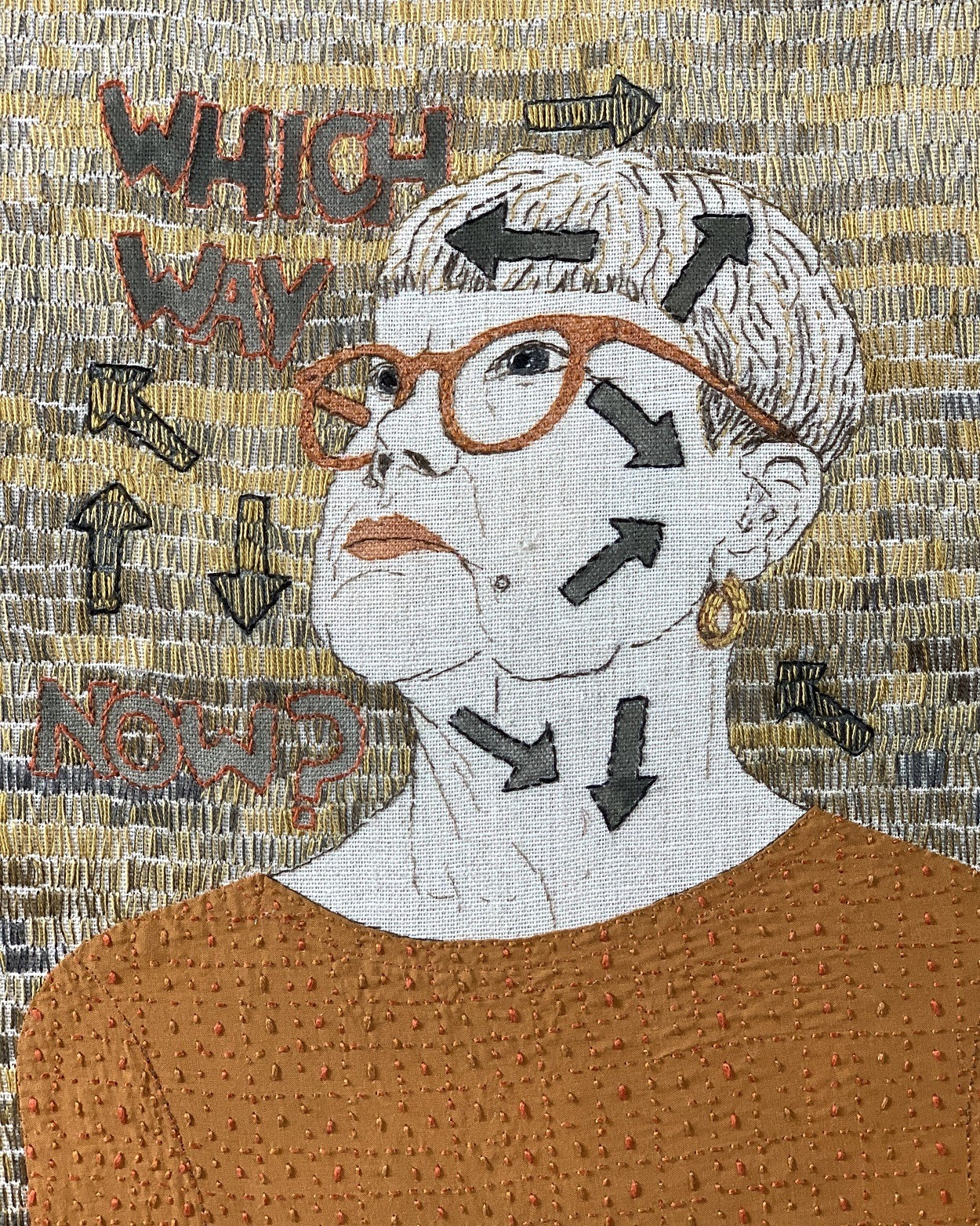
From the UK to New York City
TextileArtist.org: Tell us a bit about your textile art journey?
Sue Stone: In 1975, armed with a degree in fashion design, I returned to my childhood home in Grimsby, UK, to run a womenswear company with husband David. The business struggled, and the recession made it especially hard to succeed.
As I approached my 50s, I not only grew frustrated with the business, but also at having lost sight of my more artistic dreams. I wanted to return to exploring hand stitch as an art form. So, in 2002, I left the clothing business, and dedicated myself to rediscovering my artistic voice in 2006.
I committed to using just a handful of stitches to tell stories—most especially the running stitch, the back stitch, and a mock-herringbone stitch. I spent countless hours exploring the possibilities in each, creating sample after sample. I also experimented with threads and yarns of varying weights and colours. The possibilities were endless!
I then took what I learned to start creating portraits featuring old family characters and settings. I sought to tell rich and personal stories with the simplest of techniques and materials.
My first major show ‘Do You Remember Me?’ ran at the 2016 UK Knitting and Stitching Show, and then my work was featured on a 2017 front cover of Embroidery Magazine. I also became chair of the renowned ‘62 Group of Textile Artists.’
My artistic journey has just kept growing from that point on.
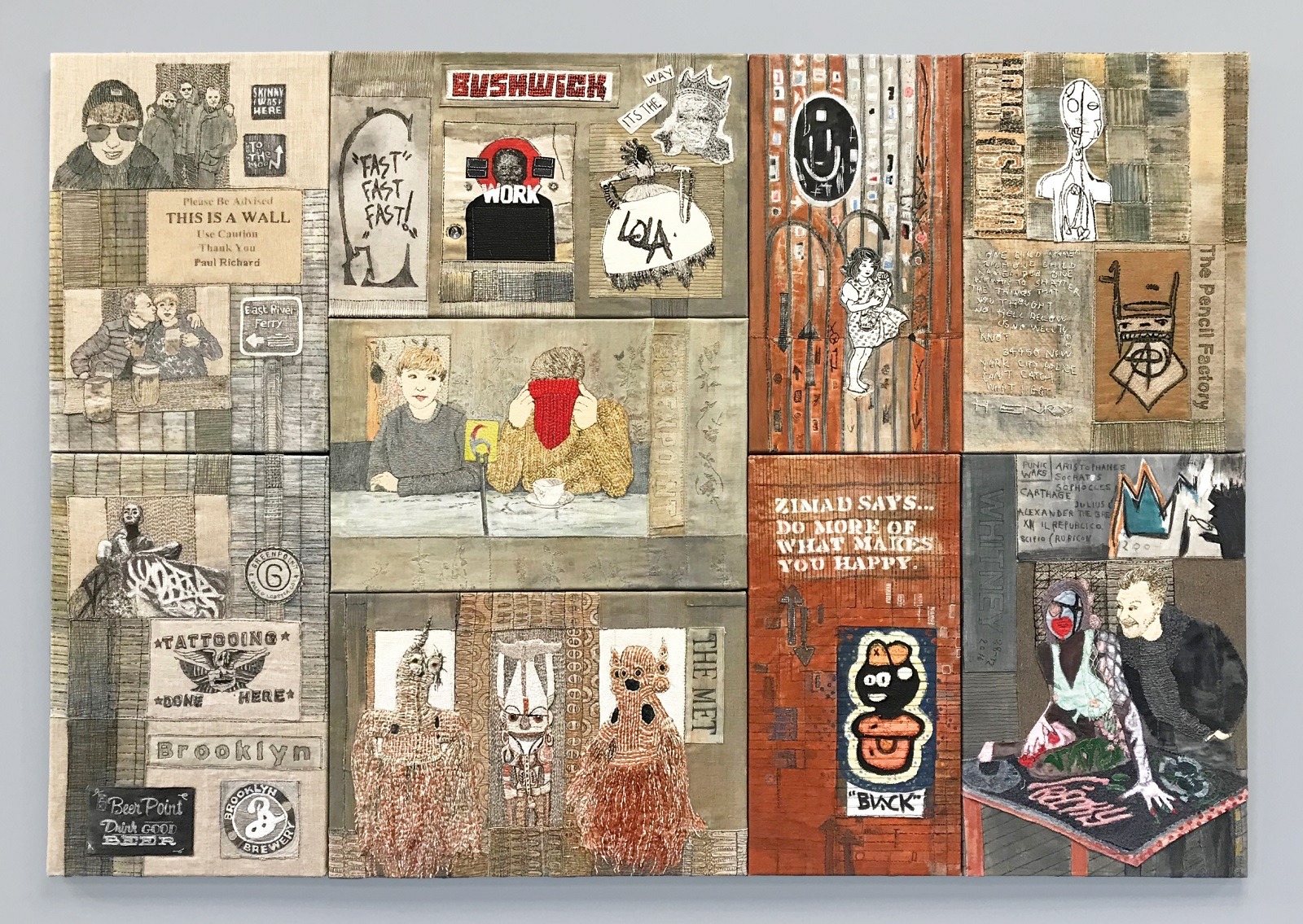
Why are the pieces based on New York? What is your connection to that city?
My younger son, Sam, and his wife, Eliana, lived in Greenpoint, Brooklyn, for several years. I hadn’t really wanted to visit New York, as I thought it would be too large and too busy. But being able to visit family obviously made it far more appealing.
Our first visit in 2016 was over Christmas and New Year’s Eve, so it was particularly special. We visited again in March, 2019.
I loved Brooklyn from the moment we arrived, and I really felt at home. Along with Greenpoint, we visited Williamsburg, Long Island, Bushwick and Dumbo. All are referenced in ‘From Grimsby to Greenpoint & Beyond.’
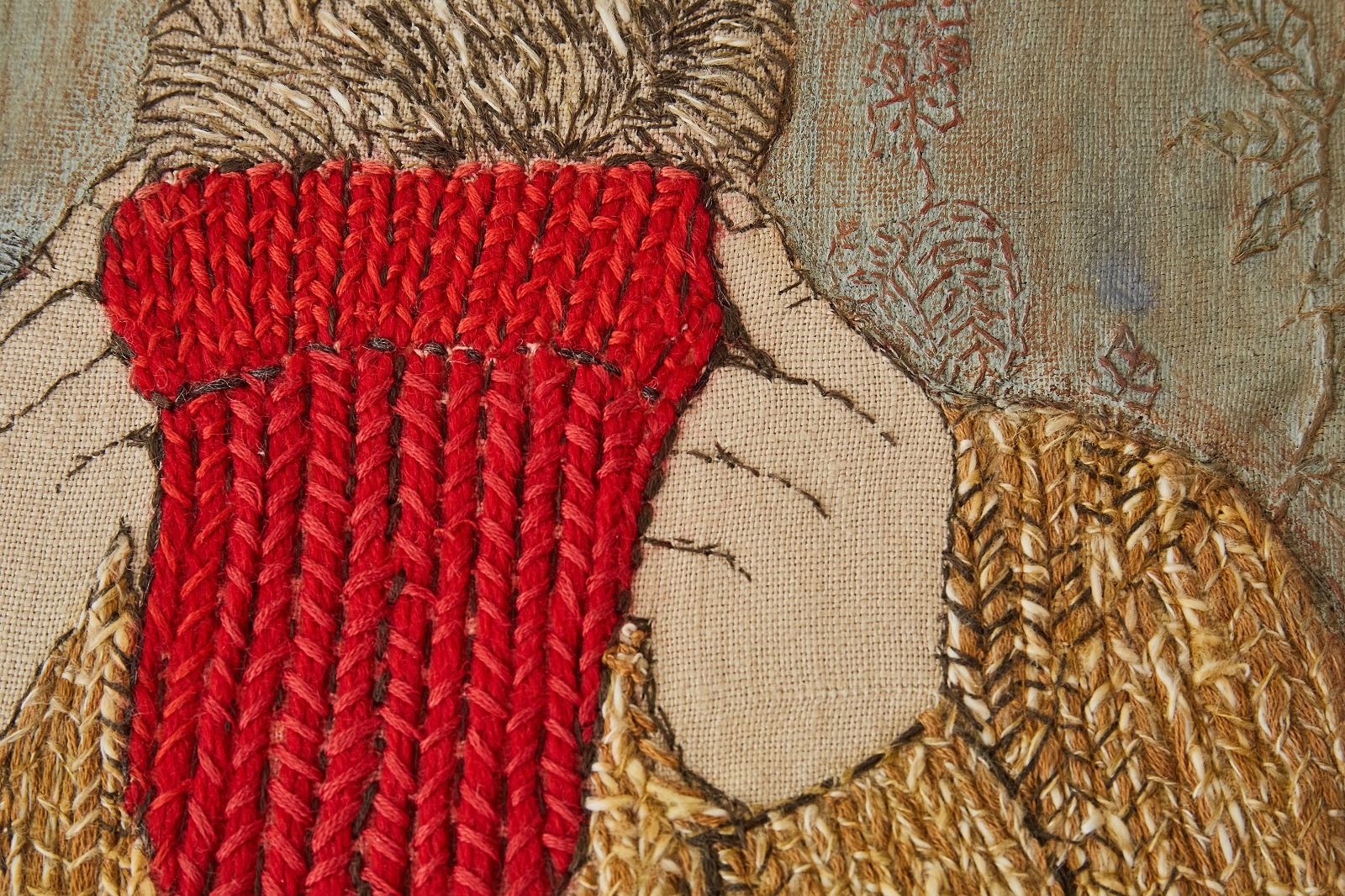
Manhattan was just as busy and chaotic as I thought it would be (and the reason behind the ‘Fast, fast, fast!’ text featured in the piece). But the art galleries and museums more than made up for the crowds and traveling on the subway—neither of which I enjoyed.
We visited MOMA (the Museum of Modern Art), the Met Fifth Avenue, New Museum and the Whitney. Again, all are referenced in the ‘Grimsby to Greenpoint and Beyond’ piece.
What I particularly enjoyed on our second visit was walking around and looking out over the East River toward Manhattan and absorbing the atmosphere. During that visit we visited the Brooklyn Museum and wondered at all the grand doors of the Brooklyn Public Library.
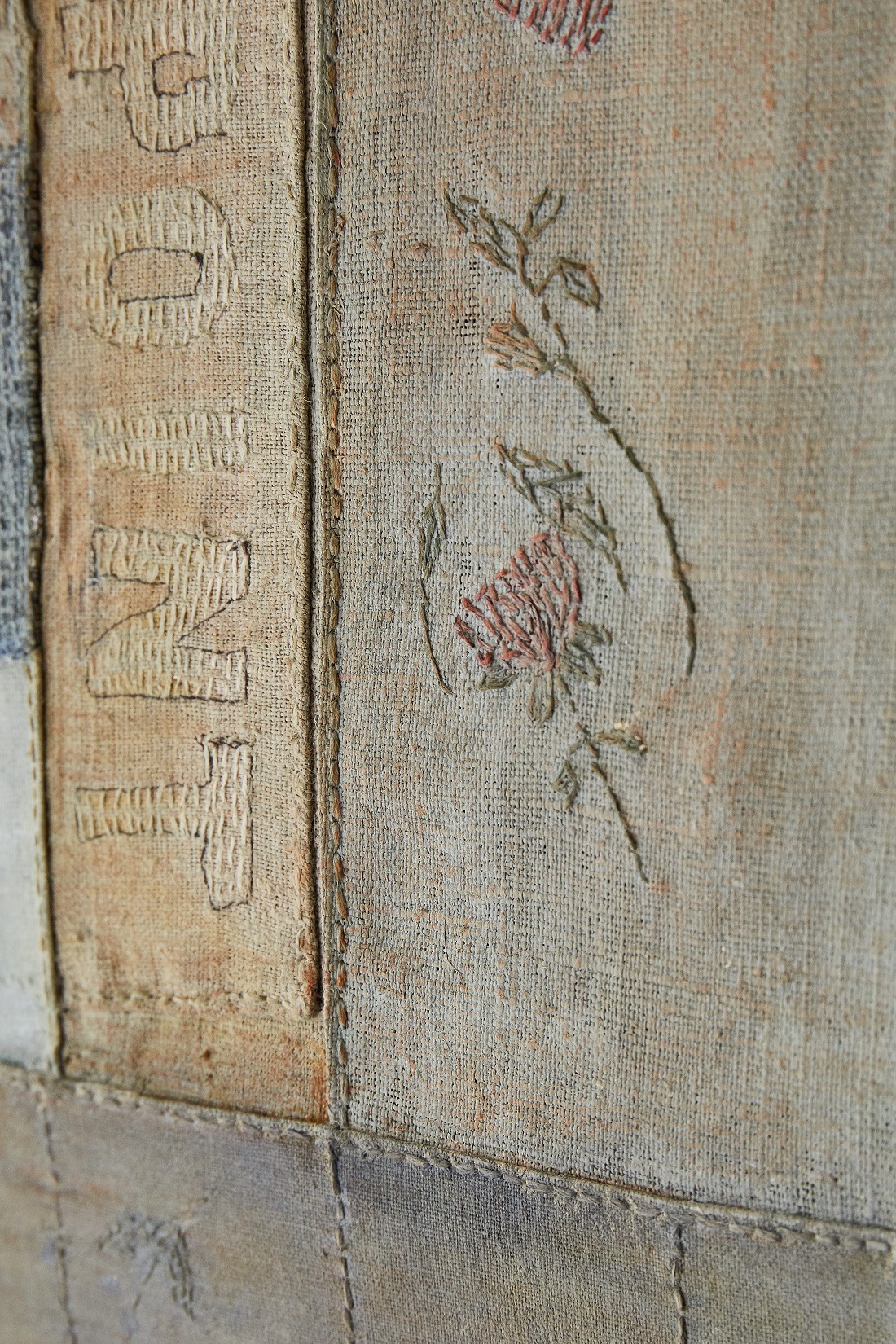
After visiting with Sam and Eli for a couple days, they left New York to travel in South America, so my husband Dave and I spent a couple days walking a lot on our own. We even walked over the Williamsburg Bridge and almost the length of Manhattan and back to avoid using the subway!
We also visited the Owen James Gallery who represent me in the USA and where I had a solo exhibition in 2017.
I’m looking forward to a return visit in 2022, but it will be without Sam and Eli, as they have now moved to Denmark!
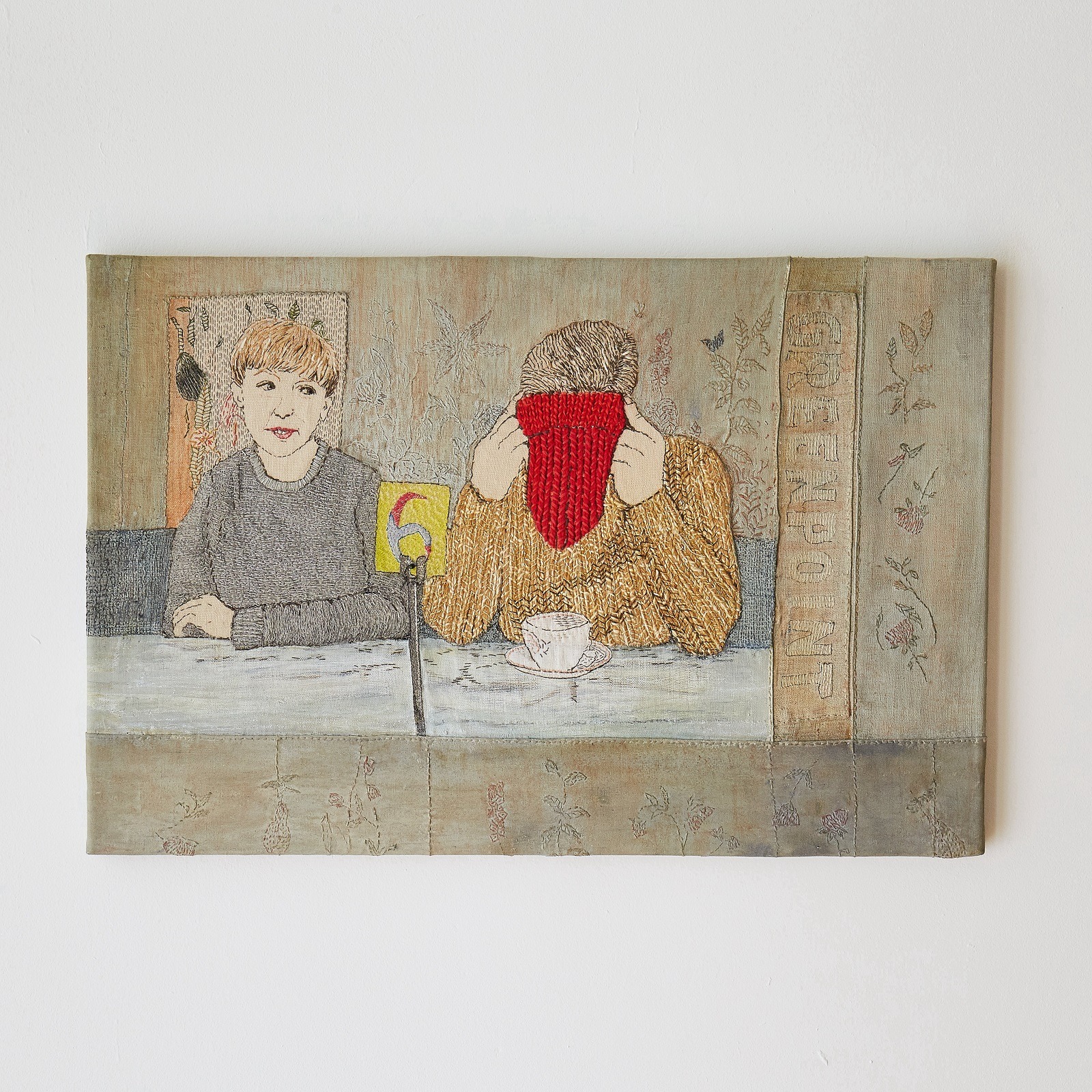
With so many pictures, how did you narrow down and choose images for the two pieces? Do the pieces feature an organizing concept or theme?
I take specific types of photos with my work in mind, and I am an avid collector of images. The accumulated textures, patterns, colours and texts provide an important source of understanding and awareness of the outside world.
Images I have taken of the unexpected and the often overlooked has become a reference library consisting of many thousands of photographs which I catalogue into folders for future use.
For each of these works, I started by choosing images I definitely wanted to include, and then other images were added to tell the story of the visit. For example, in the ‘Grimsby to Greenpoint & Beyond’ piece, I started with a picture of Sam and Eli in a coffee shop. Sam has his hat pulled over his face, and Eli is giving him ‘the look!’
For the ‘Brooklyn: Recollection, Return and Repartee’ piece, I started with an image of Sam and Eli I took outside the Brooklyn Museum. Sam was looking for something in Eli’s backpack, but I thought he looked like he was trying to steal something from her bag.
I like my narratives to be left open to interpretation, as for me, it adds to the fun of putting them together. I felt both of these images were very ambiguous.
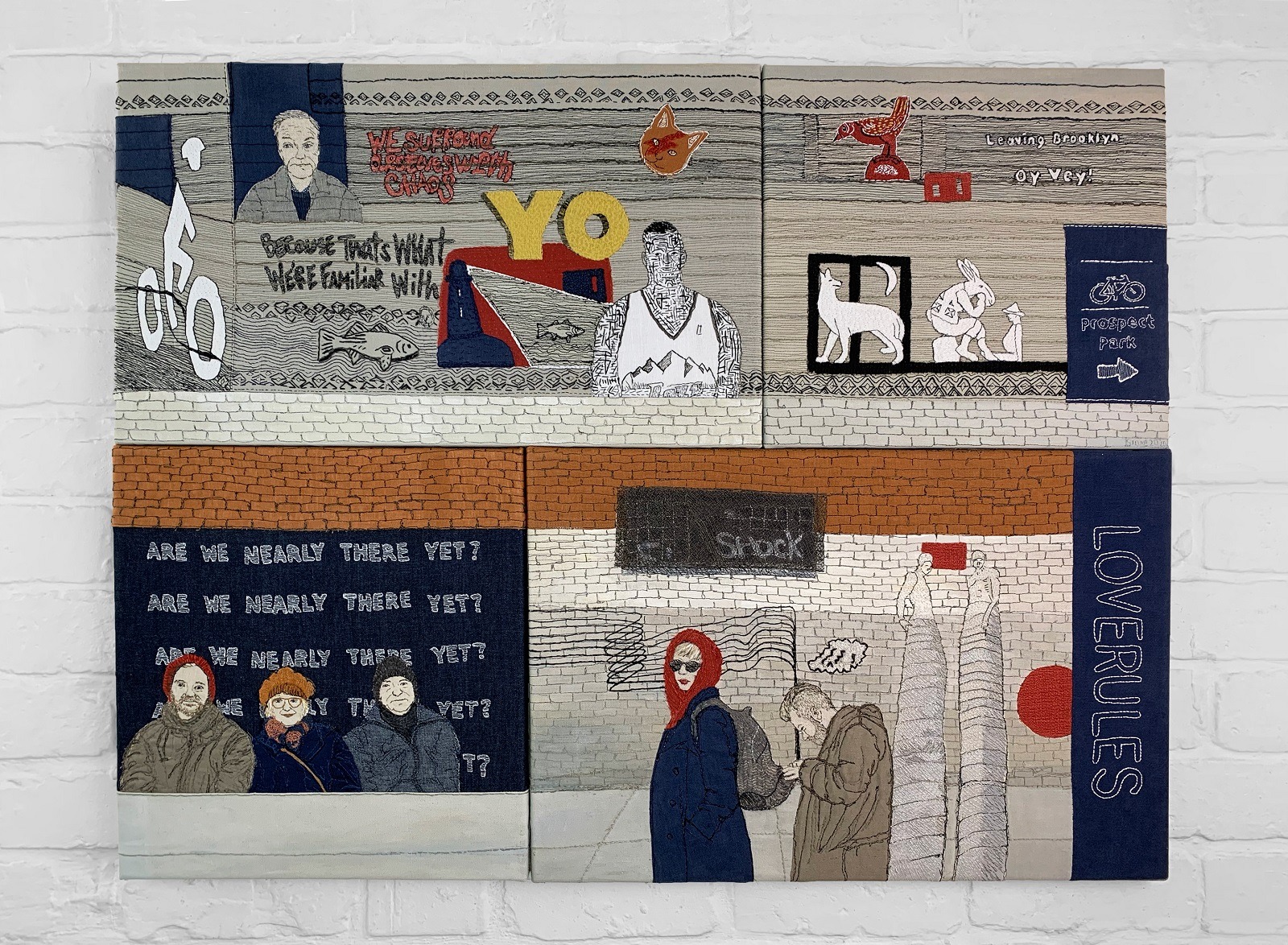
Losing control in a good way
What was your approach to creating these pieces?
Both pieces were made for exhibitions, so I was following a brief. ‘From Grimsby to Greenpoint & Beyond’ was made for an exhibition called ‘Ctrl/Shift.’ The brief required ‘shifts and changes’ as its theme, and it wanted artists from the 62 Group whose practice is or was transformed in some way. Changes could be small or large, and they could include playing with scale, using technology, using new materials, changing attitudes toward artistic control, and the impact of new concerns and ideas.
So, the first shift I made was switching from stitching people to stitching places. I also decided to use black thread (which I rarely use) to represent strength, especially for grids.
But the greatest shift I made in creating that piece was moving from a controlled process to a more emergent and organic process. To that end, I gave special attention to the sampling process and how many of those samples would become part of the final works in terms of materials.
I also used Derwent Inktense pencils for the first time.
Both works had several incarnations before I settled on the final configuration, and I’d document some of them with photos.
‘Brooklyn: Recollection, Return and Repartee’ was made for an exhibition called ‘Conversations.’ The brief for that exhibit required artists to explore the working relationship artists have with the world around them. In particular, the exhibition sought art that investigated the creative dialogue that takes place between an artist and the themes of people, place, materials and objects.
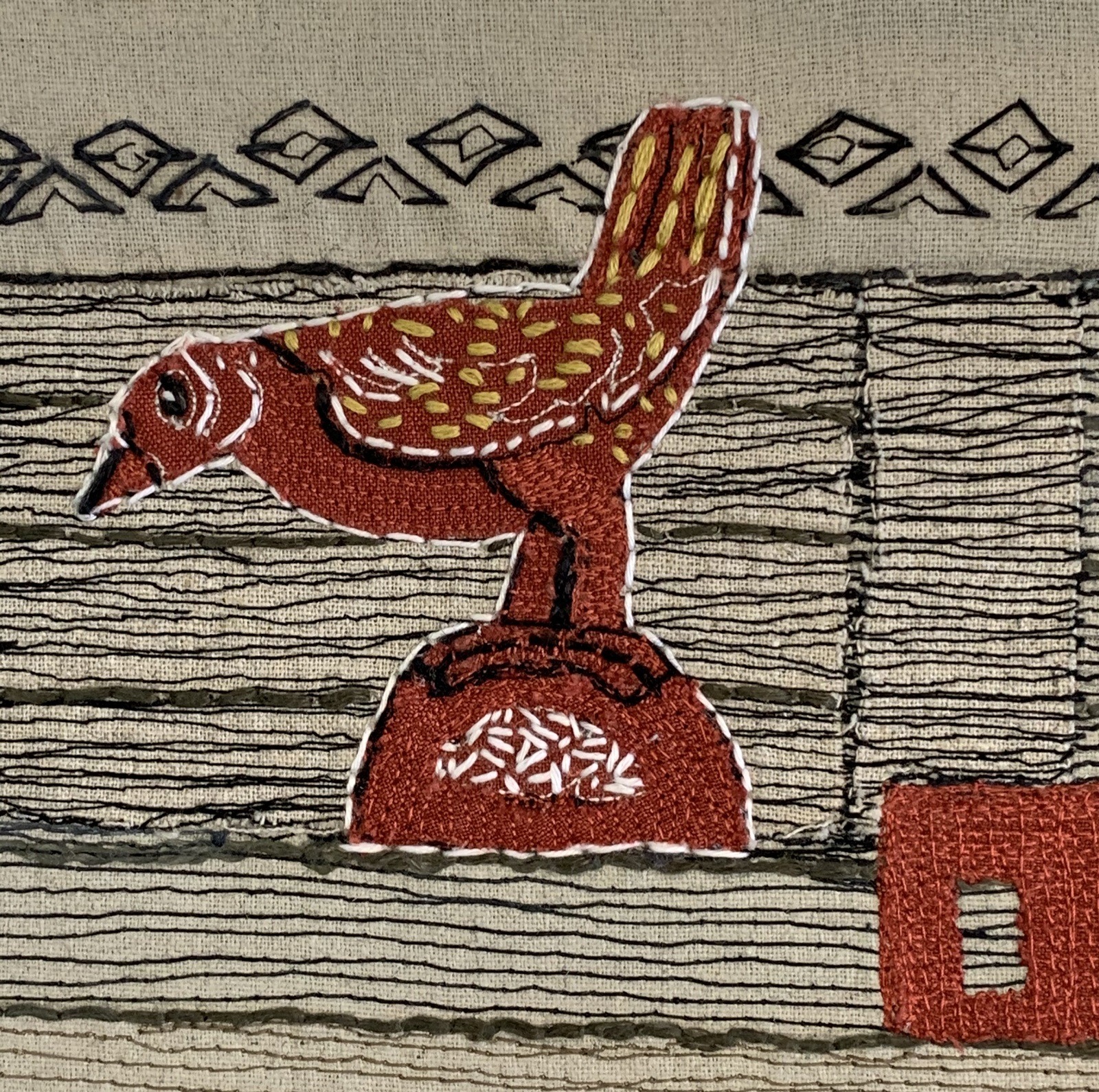
For the ‘Grimbsy to Greenpoint’ work, I developed themes largely focusing on location (such as Greenpoint, Bushwick, etc.) for each panel. For the ‘Brooklyn’ piece, it was more of an overview about destinations and what I saw on the way there.
In terms of my shift in ‘artistic control,’ it’s important to note that most of my work prior to these pieces was predesigned using computer software to combine images together to make a composition. I essentially knew what a piece would look like before I started to create.
I created these two pieces in a much more spontaneous way than normal, and it was exciting! I had no idea how they would turn out when I began making, and I really enjoyed the problem solving along the way. How could I achieve balance between the techniques used? How could I link the disparate images and panels together?
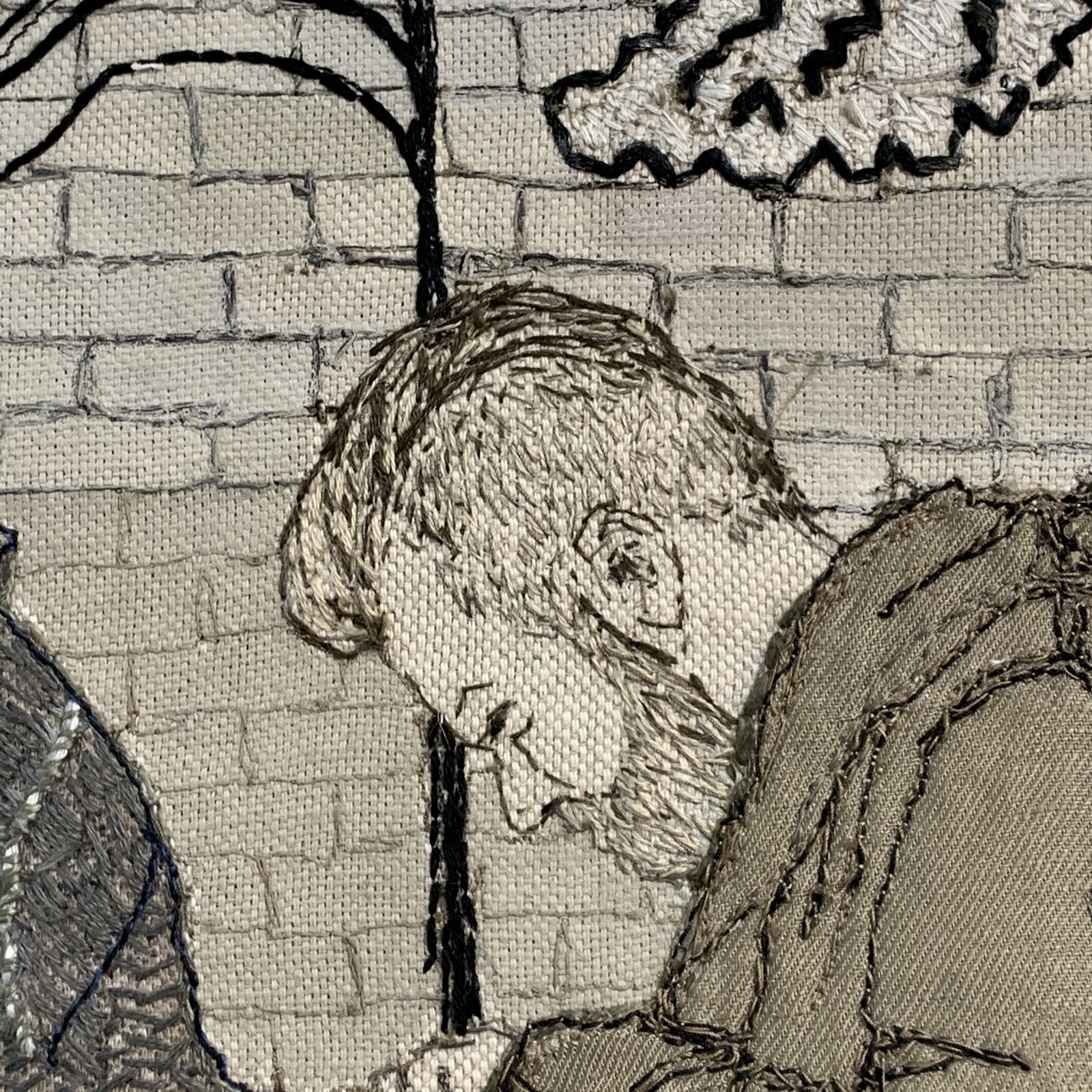
There is still an element of thought-out design in the pieces, although it’s less apparent in the ‘Grimsby to Greenpoint’ piece. I think that piece has more tension in the design than the ‘Brooklyn’ piece which is probably more harmonious.
The linking elements in the ‘Grimsby to Greenpoint’ piece include grids and lines inspired by Agnes Martin and various vertical columns which continue into the next panel. Also, each of the nine panels that make up the piece can stand alone, as well as tell the narrative as a whole.
The linking elements in the ‘Brooklyn’ work include horizontal bands of pattern and free machine stitched line, bands of free machine stitch brickwork and vertical bands of texts on the right-hand side. The use of the white, blue, red and rust colours also link the four panels together, although they can also stand alone.
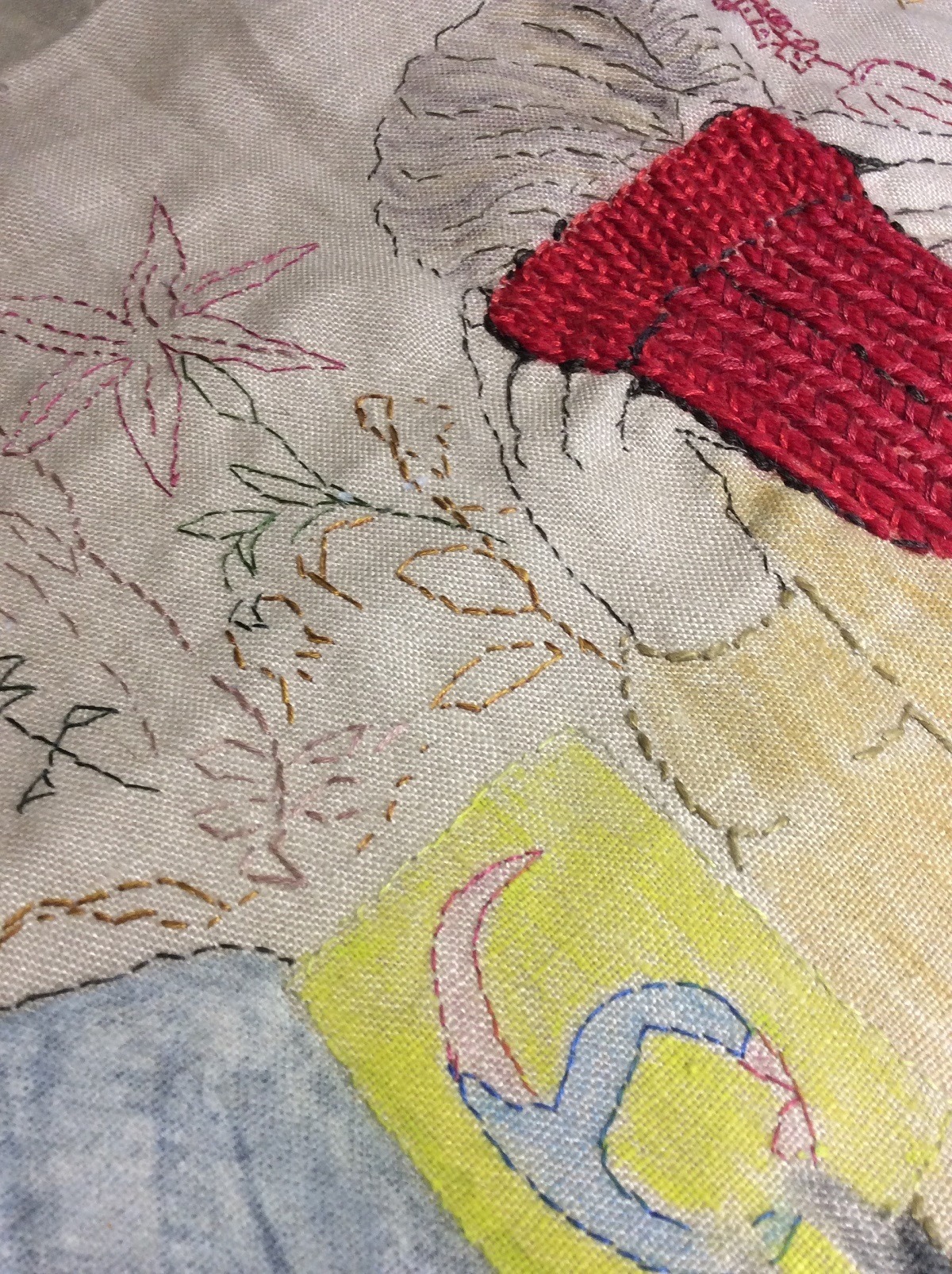
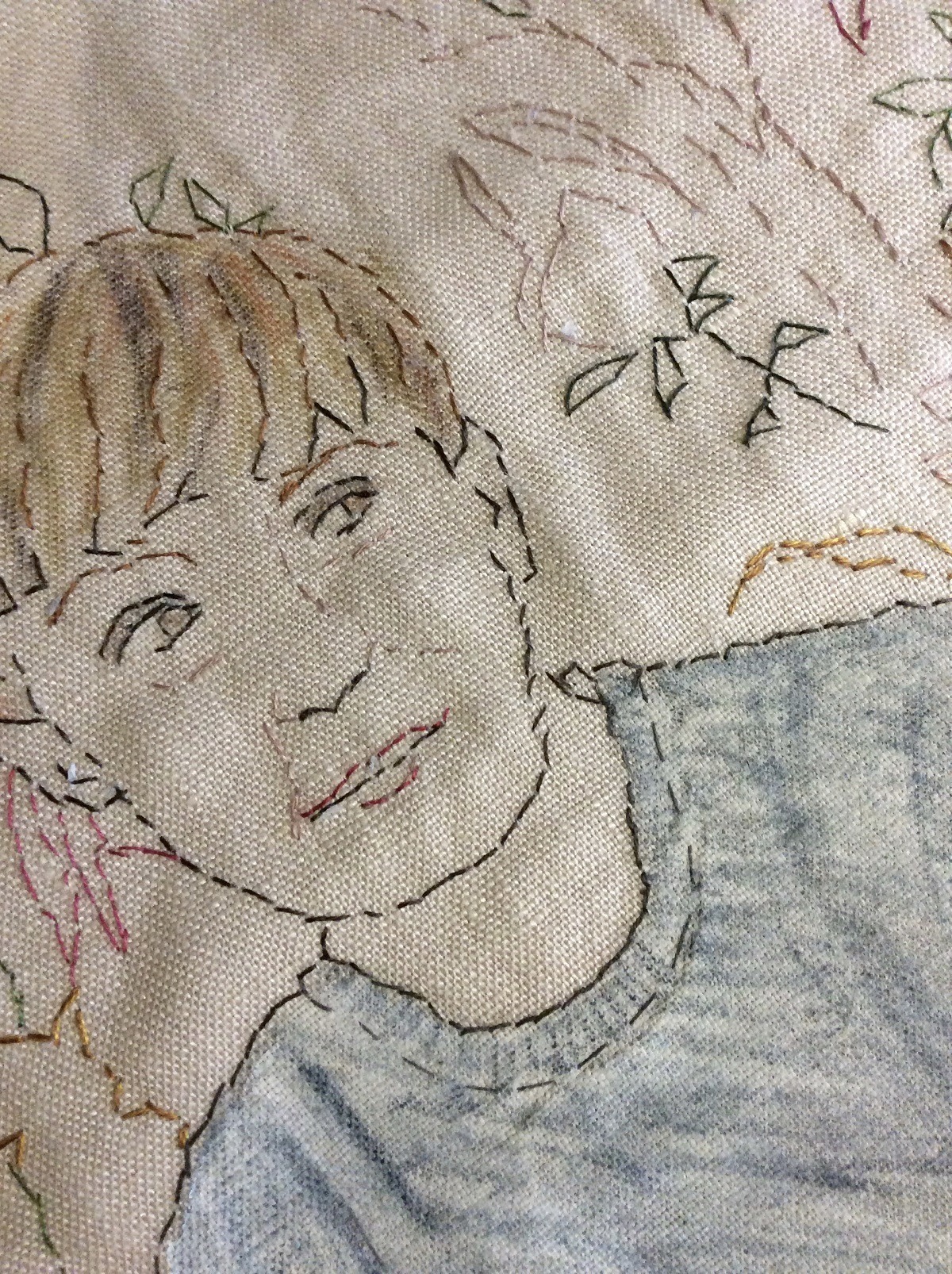
What materials did you incorporate into these pieces? How did you source them?
For the ‘Grimsby to Greenpoint’ piece, I used a basic coarsely woven linen (usually used for window cleaning) as my base. All other fabrics were recycled cotton or linen clothing fabrics donated by family and friends.
Acrylic paint and Inktense pencils were used to colour the backgrounds.

Threads included Superior Threads Masterpiece machine cotton and DMC stranded cotton. I also used linen threads bought from Linladen at the Knitting and Stitching show.
For the ‘Brooklyn’ piece, I largely used the same materials. Fabrics also included lightweight denim, and I used linen threads purchased from Honest Yarns in Maiwa, Canada.
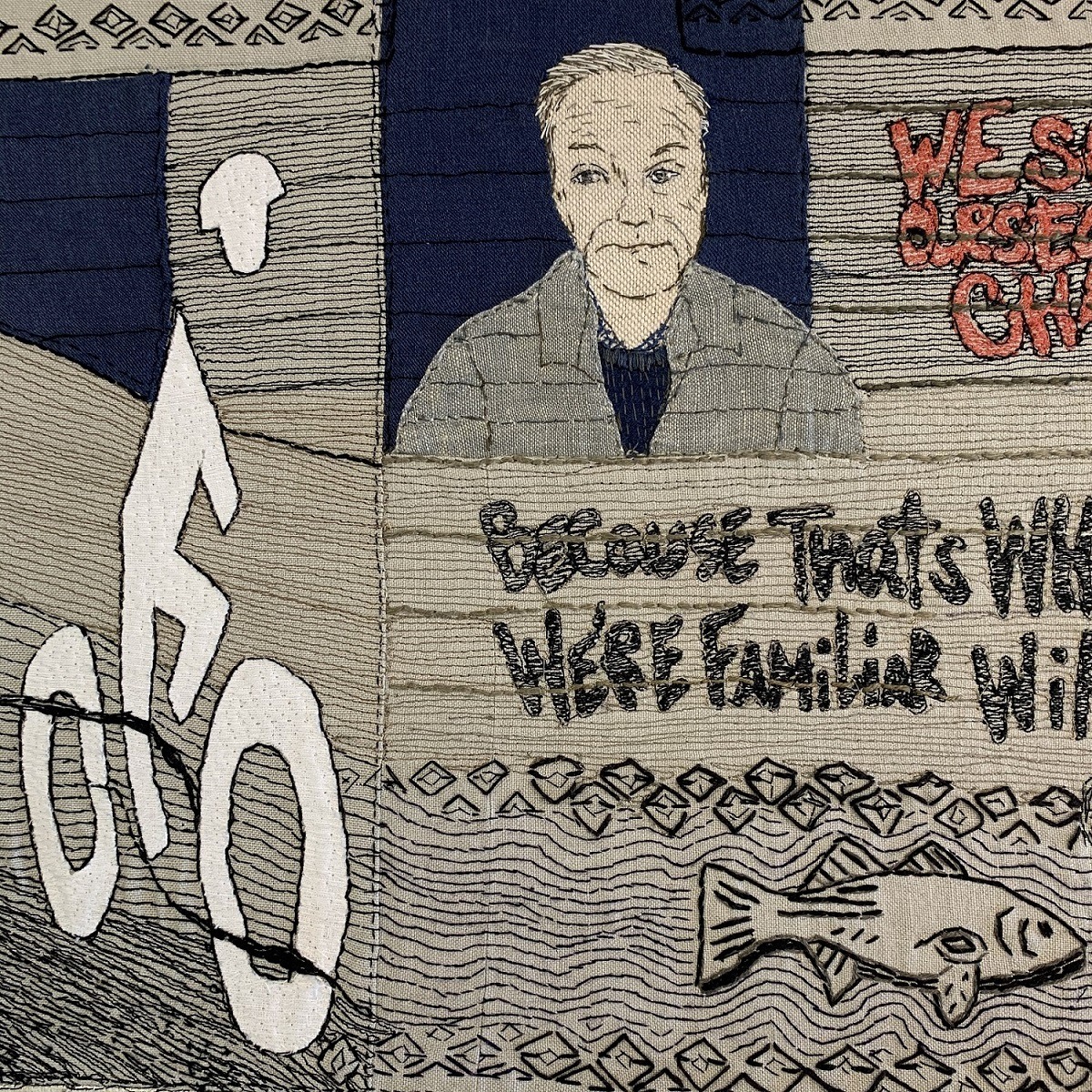
Sampling is key
Can you share a brief step-by-step description of your process?
Describing my process is difficult, as I have no formula for making my work. Each work differs from the next, and as such, I try to treat each piece with a fresh eye. So I’ll describe the process for these two works, but my next work may well have a different process. That is important to me, as I always need a challenge.
First, I gathered the images on my trips to New York and thought about the story I wished to tell about the places I visited. The thinking time is important to the process in terms of making choices about the size, format, composition, materials and techniques prior to actual construction.
I then started making small samples, some of which made it to the final cut. The first sample I made for the ‘Grimsby to Greenpoint’ work can be seen at the top left side of the top left panel. It’s a small hand-stitched portrait of Eliana taking a selfie with me, my son, Sam, and husband, Dave, in the background.
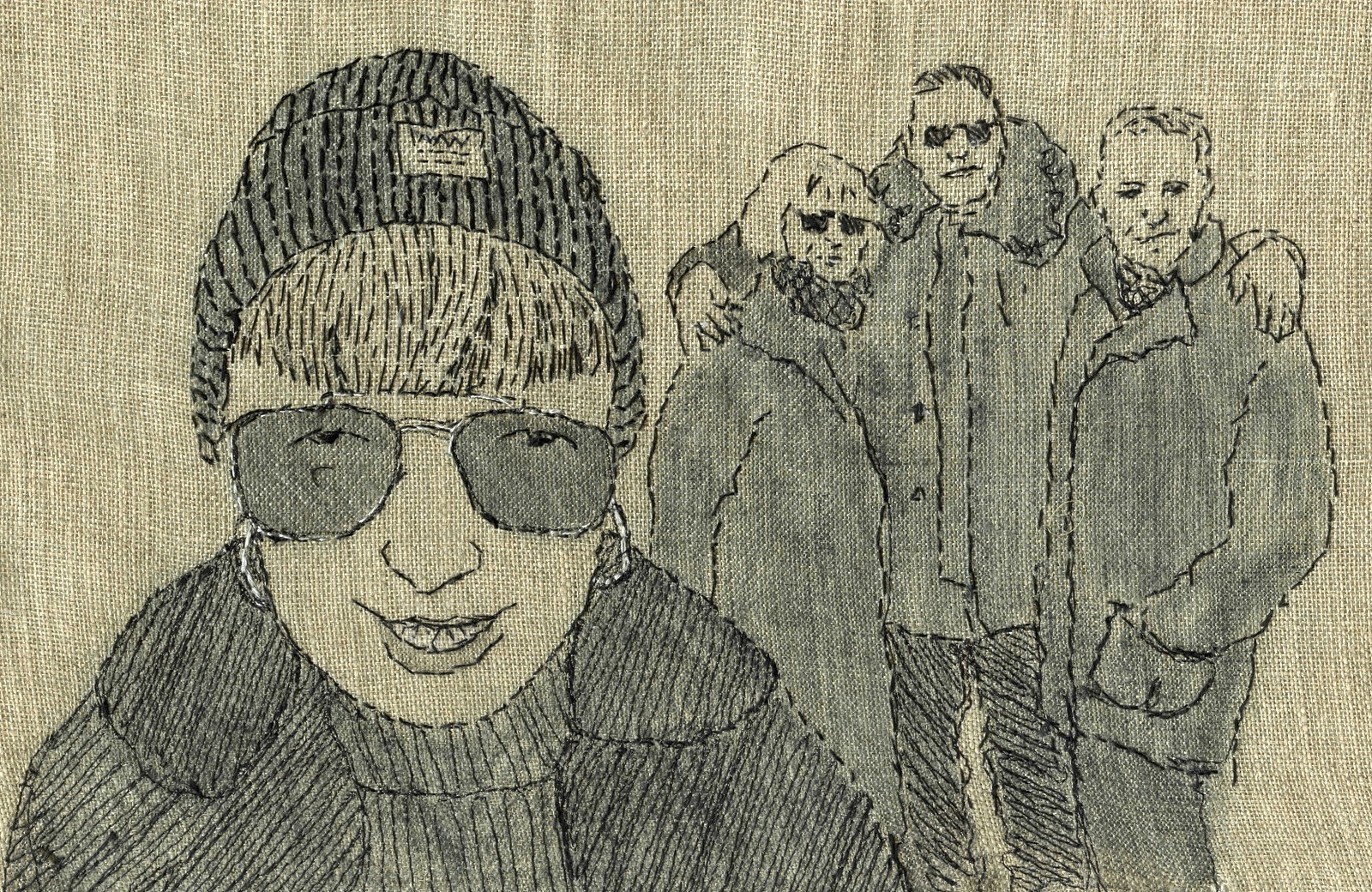
For the ‘Brooklyn’ work, the first sample I made was the small hand-stitched portrait of my husband, Dave, on the blue background at the top left.
So, although both pieces are about place and time, they both started off with people. And although there’s a lot of free machine stitch in these pieces, they both started with a basic uneven backstitch by hand.
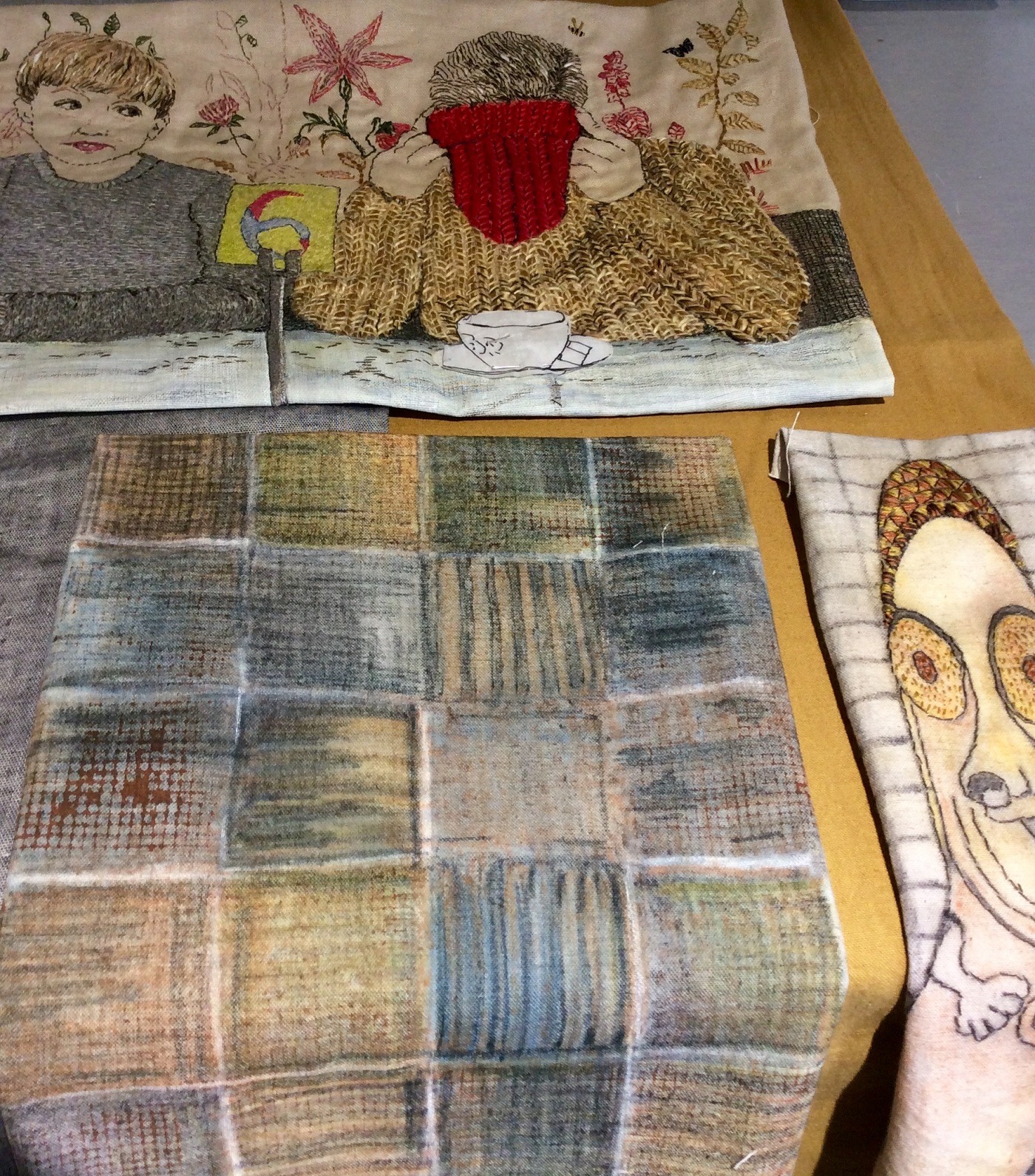
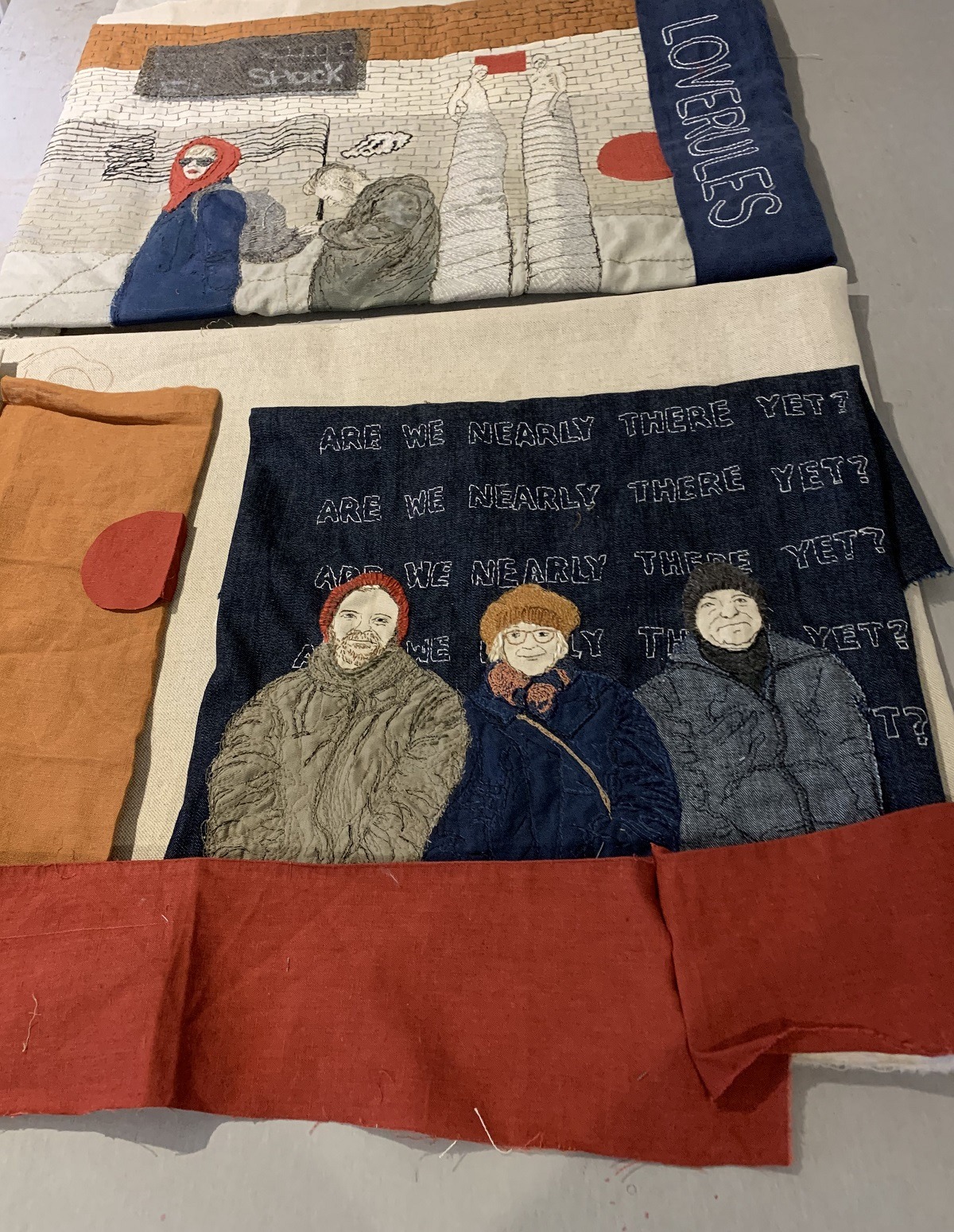
Once I’d built up a pile of stitched sample, I began to think how I could combine them into a coherent composition. I arrange and re-arranged. I tried different ways to link the panels together by laying different coloured fabrics next to the embroidered pieces.
The samples were collaged onto a larger fabric background using running stitch, backstitch and free-machine stitch. I also used raw edge, turned-in edge and fused fabric applique.
Backgrounds were pre-coloured with watered down acrylic paint and Inktense pencil. Then I overpainted with acrylic paint.
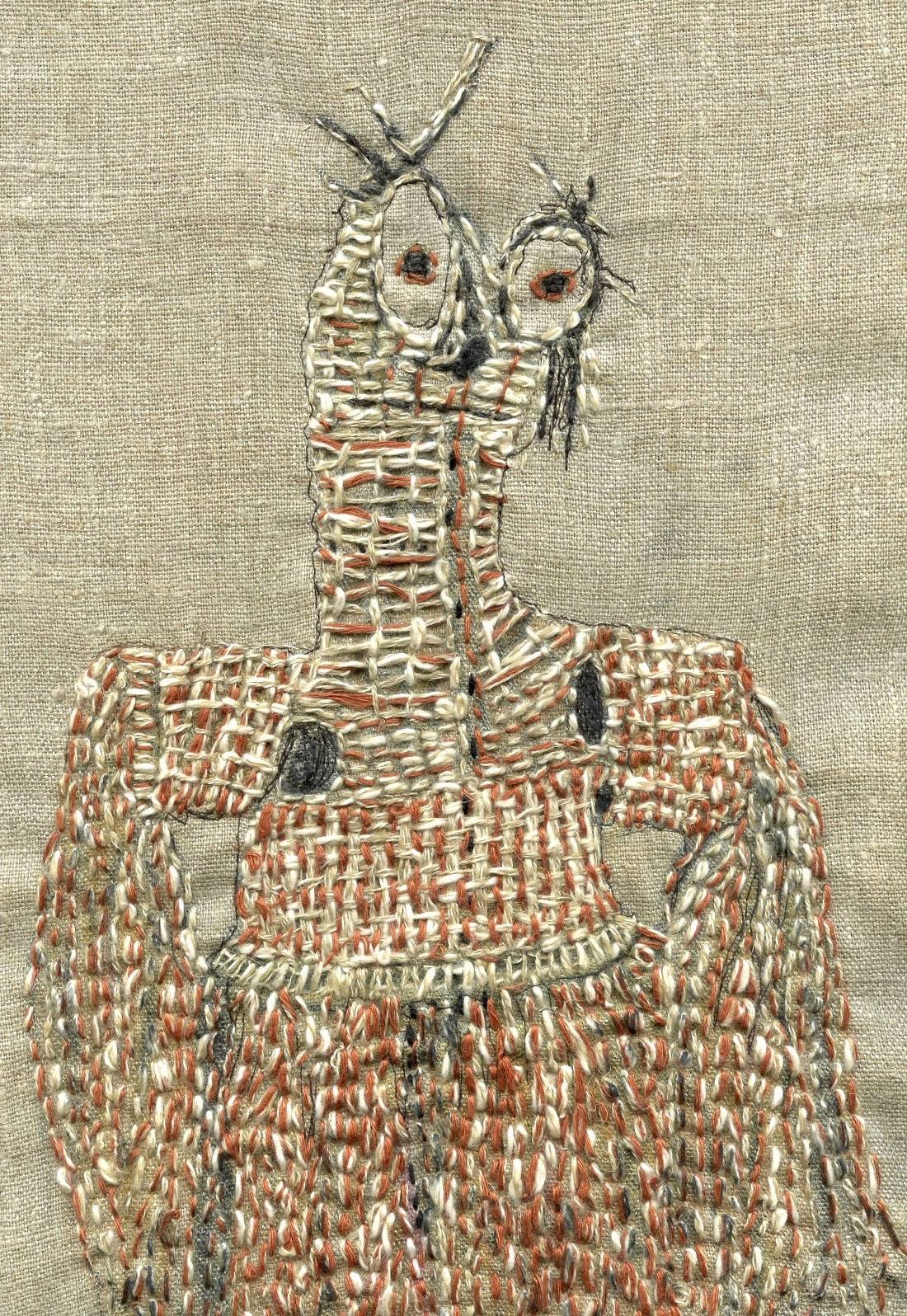
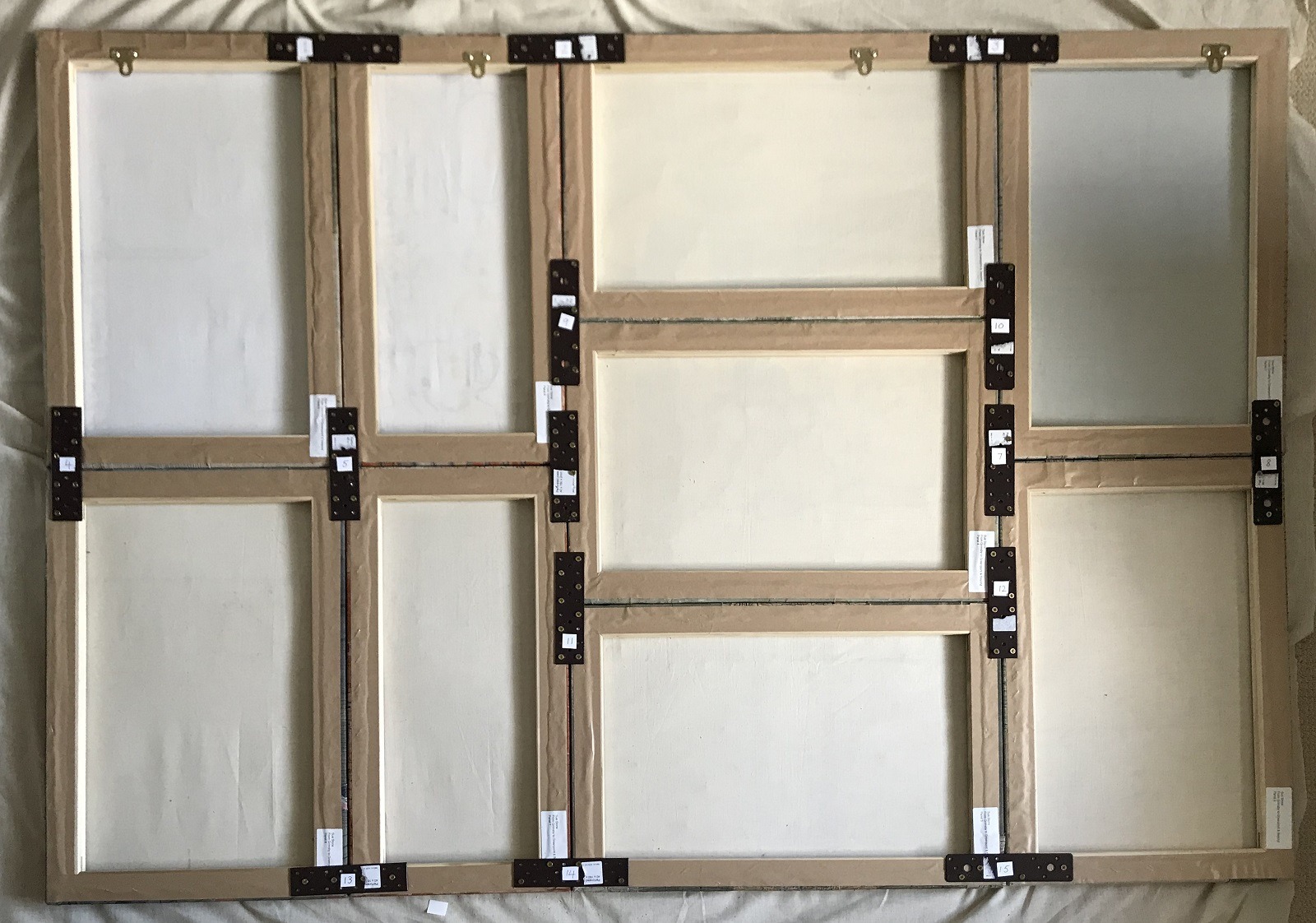
How are the pieces displayed? And have they been featured in any exhibits?
Both pieces are two-dimensional and wall hung using mirror plates. The panels are fixed together with flat metal plates for display as one large piece. ‘Grimsby to Greenpoint’ has nine panels, and ‘Brooklyn’ has four.
‘From Grimsby to Greenpoint’ was part of the UK touring exhibition ‘Ctrl/Shift’ (July, 2018 ) sponsored by Arts Council England and MAC Birmingham. The exhibition also toured to NCCD Sleaford and 20:21 Visual Artist, Scunthorpe, ending in 2020. A full-colour catalogue is available here: https://www.62group.org.uk/publications-2
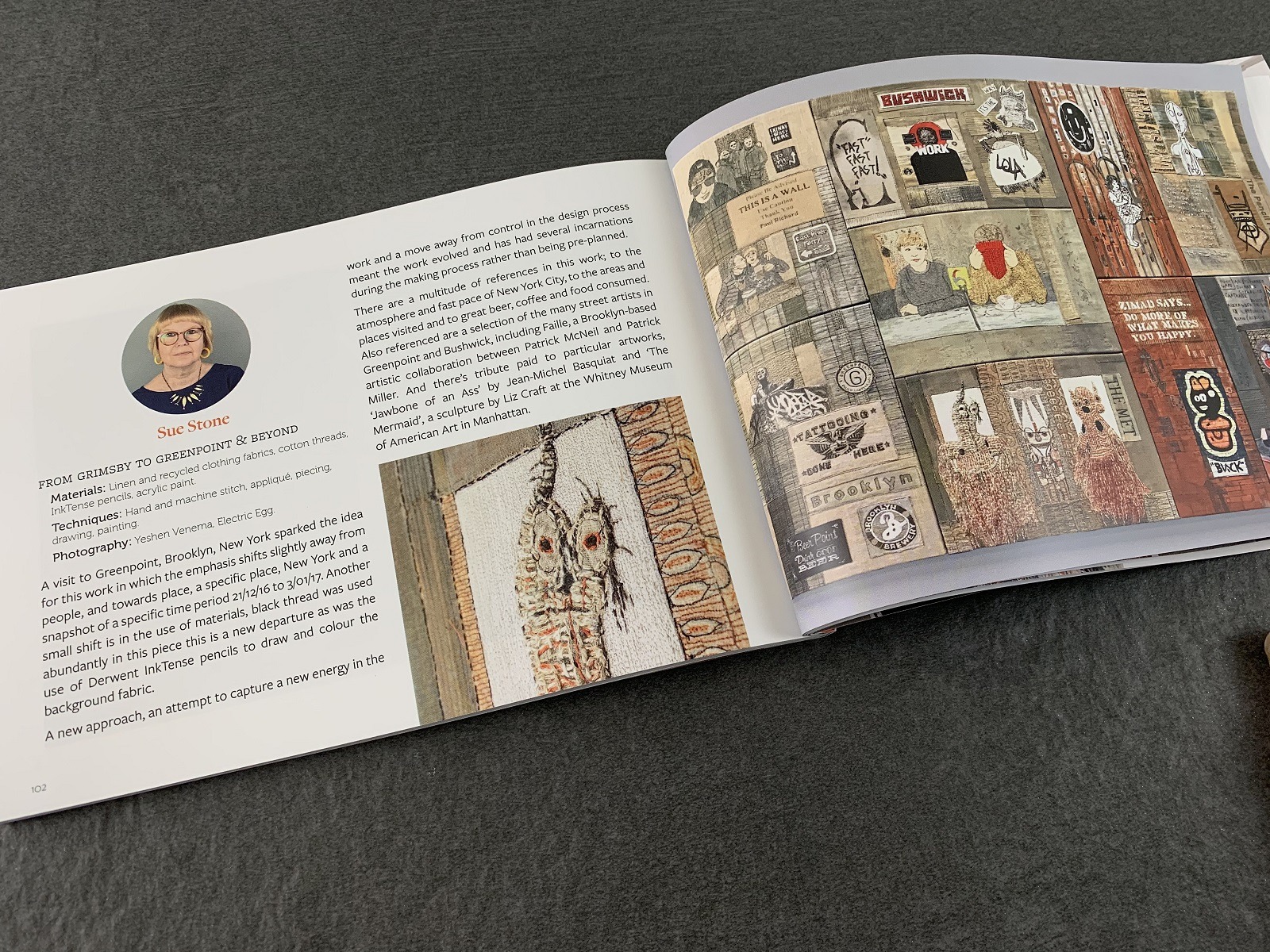
‘Brooklyn: Recollection, Return and Repartee’ was submitted to the 62 Group exhibition ‘Conversations.’ It was finished days before the March, 2020, deadline, but sadly neither the selection or the exhibition took place due to Covid. It has now been rescheduled for January, 2022. Every submitted work has to go through a selection process for a 62 Group show, so I won’t know until later this year if it has been selected. Fingers crossed!
Details of that exhibition can be found here: https://www.62group.org.uk/exhibitions/conversations/
For more information visit www.womanwithafish.com/
Have you used your own travels as a theme for your textile art? If so, let us know about your materials and techniques below.
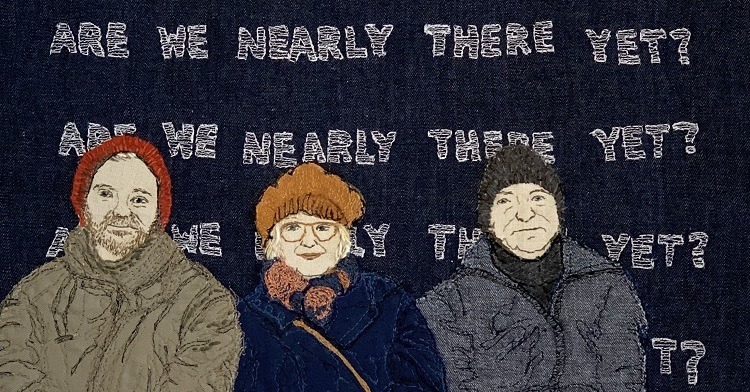
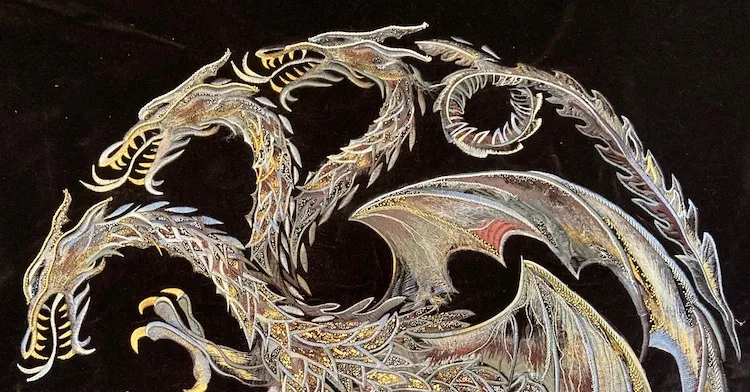
![Contemporary textile artist Lisa Soloman featured image||Lisa Soloman - Sen [1000 doilies]](https://www.textileartist.org/wp-content/uploads/Lisa.jpg)
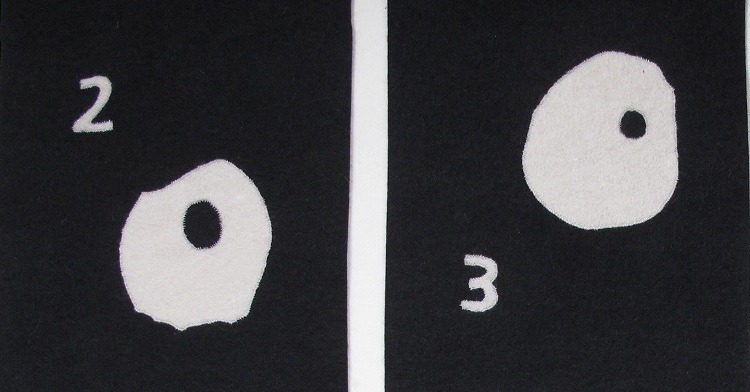
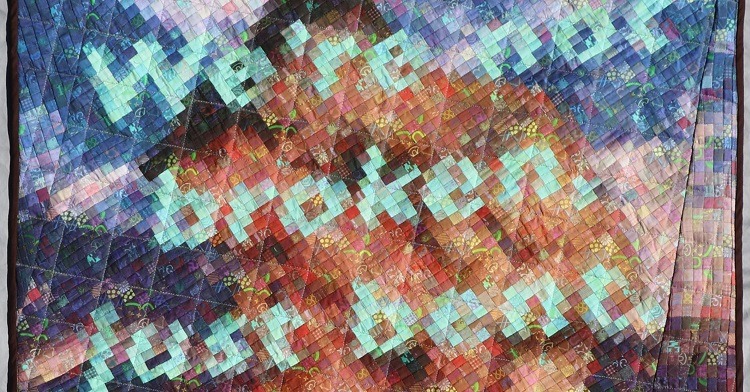
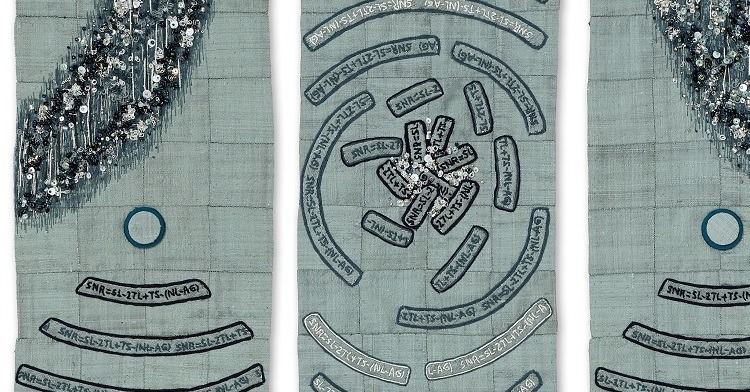
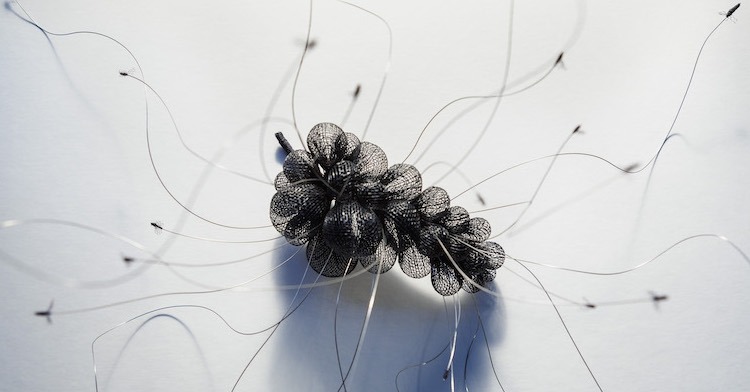
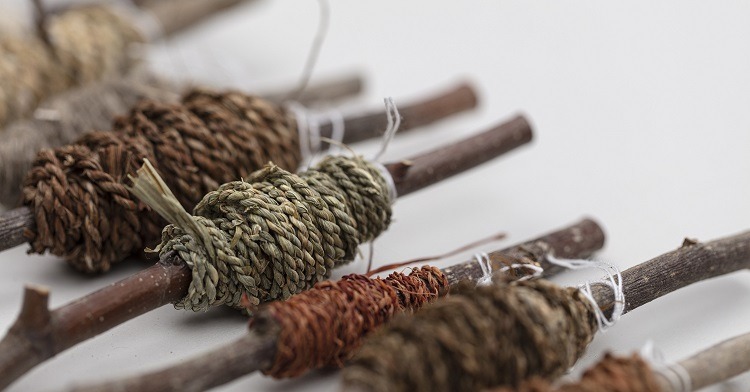
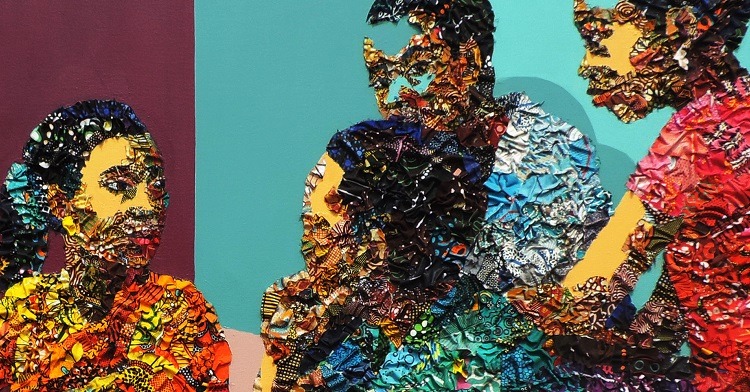

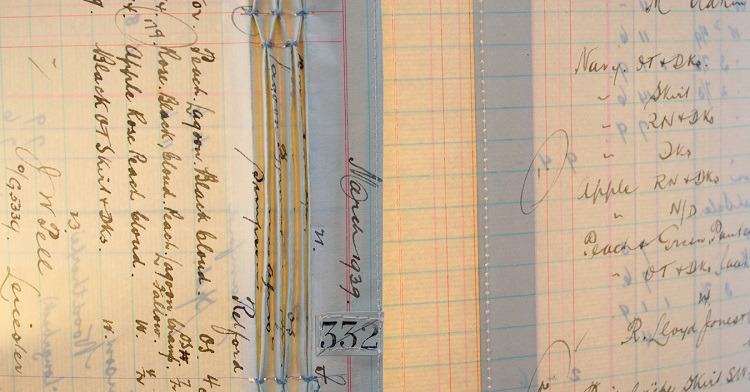
2 comments
Donna Pree
Thanks for sharing your story and photos . I still appreciate the challenges that you provided during Covid!
Marilyn Beeston
Fantastic, inspirational, WOW love your quirky faces.Coming from Sydney, Australia we grow up with the travel bug in our veins and first stop is usually London or more precisely Earls Court SW5??
Photography back in the late 60’s early 70’s you took slides and had “slide nights” and bored everyone stupid. Some travelled with good cameras, otherwise a small compact “instamatic ” did a reasonable job.
I am going to find time to read through your textile journey, as I have some ideas now after just rolling through and looking at the pictures. Thank you, I look forward to the next post from Travel Org.